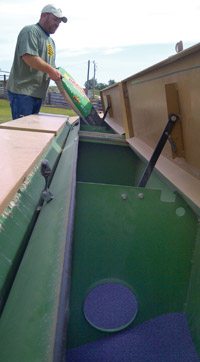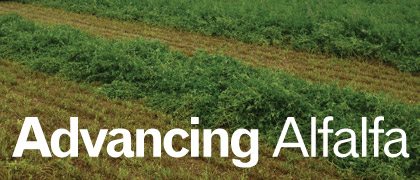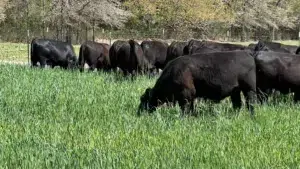Following the successful introduction of Roundup Ready alfalfa, a new genetically engineered trait is in the works that promises to deliver a higher quality forage crop.
Since 2011, after more than a decade of product development and a prolonged deregulation battle, Roundup Ready technology has been available to American alfalfa producers. In addition to this biotech solution to weed control in alfalfa, growers could reap the benefits of a second GM trait promising higher quality alfalfa within the next few years.
An application by Monsanto and Forage Genetics International for deregulation of a new GM alfalfa—genetically engineered for reduced lignin content and improved forage quality—is currently under review by the U.S. Department of Agriculture.
 Grower Quentin Maupin fills up his planter with Dekalb Roundup Ready alfalfa seed as he prepares to plant his field in Paradise, Kan. |
“We’re tremendously excited about reduced lignin [which is] the first forage quality trait in GE alfalfa,” says Mark McCaslin, vice president of research for FGI. “I’ve been talking about it at grower meetings the last three or four years as we were doing the discovery phase and proof-of-concept. [There’s] a lot of excitement among growers.”
Lignin is a structural component of alfalfa plants that is indigestible by livestock. The new trait was developed by suppressing a key enzyme during the plant’s synthesis of lignin, resulting in a 12 percent lower lignin content according to the deregulation petition before the USDA.
“Rather than putting a new gene in, we took an existing gene and turned down the volume—commonly called a ‘knock out.’ So from a regulatory standpoint, it’s a little different,” says McCaslin. “I wouldn’t say that will expedite the regulatory process, but it probably simplifies some of the analysis.”
The developers of the new trait maintain reducing lignin may provide more flexibility for growers, who typically only have a short window for reaping alfalfa before lignin content increases substantially and crop quality declines.
“In producing high-quality alfalfa, there are trade-offs between forage yield and forage quality. Alfalfa’s forage quality—digestibility and protein—is highest during the early growth stages. After early growth, forage yield will increase, but forage quality decreases. This is because, as the time between cuttings grows longer or if plants are harvested at later stages, the yield per cutting may increase due to more stems and larger stems,” explains Kathleen McAleenan, specialty crops business manager for Monsanto Company.
“On the other hand, overly mature forage is less nutritious because of its higher fiber content. Oftentimes growers are faced with tough choices between quantity and quality with their alfalfa acres, so there’s inherently a lot of risk in the decisions growers make. Because of this, many growers continue to be very interested in the potential benefits that reduced lignin alfalfa can bring to their operation,” she adds.
“The goal of the reduced lignin effort is to provide farmers with harvest flexibility when adverse weather, equipment failure or competing farm activities arise and to better manage the yield-quality relationship for their alfalfa forage production.”
McAleenan says the added yield or quality premium will benefit both growers and users of alfalfa. “High-quality alfalfa in dairy cattle rations increases milk production while controlling feed costs, but getting enough high-quality alfalfa is an on-going challenge as growers must typically sacrifice yield for quality,” she explains. “Because of the important role alfalfa plays in a dairy operation’s profitability, we believe this particular agricultural investment will make a positive difference for growers seeking to produce more high-quality hay.”
Monsanto and FGI also teamed up for Roundup Ready alfalfa, genetically engineered to resist glyphosate herbicides.
“We’ve had a couple of sales years now, and we’re feeling good about the fact that farmers are finding value in the trait,” says McCaslin. “It’s a unique tool for weed control in alfalfa, especially during establishment, but also [for] control of perennial weeds in established stands.”
In late 2011, the University of California released the results of a survey that showed 72 percent of respondents who grew Roundup Ready alfalfa would grow it again. FGI has conducted its own market research that echoes those findings.
“We’ve done quite a few grower surveys to try to get feedback from the growers in terms of their experience with Roundup Ready technology, and what we see generally in all parts of the country is … those growers who are trying it are reporting to us that they’ve had a positive experience and are planting more acres,” says McCaslin.
McAleenan agrees that Roundup Ready alfalfa continues to be well received by growers, citing a recent grower survey in which 97 percent of users reported being satisfied with the technology.
“Growers recognize that weed competition in the establishment year reduces alfalfa yield potential and forage quality over the life of the stand. These growers know that better stands mean more productivity, longer,” she says. “We’ve asked early adopters what they like most about the product, and time and again we hear that the technology makes our growers’ lives easier and that the added yield pays for the technology in year one of the stand’s life.”
McCaslin says the new GM traits being introduced by FGI and Monsanto are creating quite a buzz throughout the alfalfa industry, and not just among growers.
“To add value to the seed … is a good thing, both for the industry and for American agriculture. I think the industry is going be supportive of anything that adds value to crops [and] helps farmers be more profitable,” he says. “Anything that makes growers happy, the industry is excited about. That’s true for us as a company and the seed industry generally.”
For this reason, the folks at FGI are particularly excited about the prospect of combining Roundup Ready technology with the reduced lignin trait currently in the pipeline.
“We think both of these traits add significant value and flexibility for growers in terms of doing a better job controlling weeds, providing more flexibility in cutting management and increasing the likelihood of producing high-quality hay, for which they get paid a premium,” says McCaslin.
Mark Halsall
| BIG PICTURE PROJECTS Reduced lignin alfalfa was developed by the Consortium for Alfalfa Improvement, a group comprised of researchers from the U.S. Dairy Forage Research Center, the Noble Foundation, DuPont Pioneer and Forage Genetics International. Founded in 2001, the CAI represents a unique union of government, private non-profit and for-profit scientists dedicated to improving alfalfa characteristics such as yield, nutritional content and digestibility. “The reason we put this consortium together was the realization that companies and institutions have limited dollars to spend for these really long-term, big picture projects,” says Mark McCaslin, FGI’s vice president of research. By combining resources, CAI researchers have been able to “move the mark” in alfalfa research and development, he adds. “There are probably 20 scientists among the four organizations that met twice a year to make all this happen,” McCaslin says. “I think it’s a great example of an unconventional relationship of organizations that are all committed to making a significant change to alfalfa.” |













